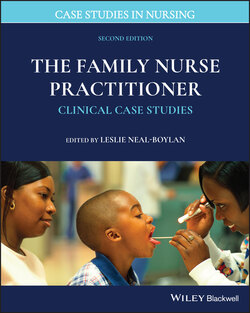Читать книгу The Family Nurse Practitioner - Группа авторов - Страница 15
ОглавлениеCase 1.2 Pulmonary Screening Exam
By Mikki Meadows‐Oliver, PhD, RN, FAAN
SUBJECTIVE
Cassidy, a 12‐hour‐old female, was born at home via planned home birth. She was brought into the office for an initial health maintenance visit. On initial examination, she was found to have rapid breathing when the office nurse weighed her. Cassidy is accompanied by both parents. There are no parental concerns.
Birth history: Cassidy is the product of a 40‐week gestation. She was delivered vaginally at home by a certified nurse midwife. During the pregnancy, Cassidy’s mother had no falls, infections, or known exposures to environmental hazards. She did not drink alcohol, take prescription medication (other than prenatal vitamins), use tobacco products, or use illicit drugs. The total labor duration was 2 hours. Cassidy’s birth weight was 3380 g and her Apgar scores were 9 at 1 minute and 9 at 5 minutes.
Social history: Cassidy was born to a 37‐year‐old mother. Cassidy is the second child and has a 3‐year‐old sibling. She lives at home with both parents and her older sibling. The family employs an au pair who also resides in the home. Both parents are college educated. The mother works as a research assistant, and the father works as an accountant. There are no pets or smokers in the home.
Diet: Breastfeeding ad lib, but mother feels that Cassidy is having problems latching on. Colostrum is present. Milk has not come in yet.
Elimination: Urinated at birth, and has had 3 wet diapers since that time. Passed meconium at 10 hours of age.
Sleep: Sleeps between feedings.
Family medical history: PGF (age 67): sarcoidosis; PGM (age 63): healthy; MGF (age 64): Type 2 diabetes; MGM (age 64): history of MI at age 63; mother (age 37): healthy; father (age 42): healthy; Sibling #1 (age 3): healthy; history of bronchiolitis.
Medications: Currently taking no prescription, herbal, or over‐the‐counter medications.
Allergies: No known allergies to food, medications, or environment.
OBJECTIVE
Vital signs: Weight in the office today is 3360 g; length: 48 cm; temperature: 37.2°C (rectal); pulse oximeter reading: 95% on room air.
General: Alert, active baby.
Skin: Clear with no lesions noted; no cyanosis of skin, lips, or nails; no diaphoresis noted; skin turgor intact.
Head: Molding present; anterior fontanel open and flat (2 cm × 2 cm); posterior fontanel open and flat (1 cm × 1 cm).
Eyes: Red reflex present bilaterally; pupils equal, round, and reactive to light; no discharge noted.
Ears: Pinnae normal; tympanic membranes gray bilaterally with positive light reflex.
Nose: Both nostrils patent; no discharge; mild nasal flaring.
Oropharynx: Mucous membranes moist; no teeth present; no lesions.
Neck: Supple; no nodes.
Respiratory: RR = 68; crackles present in lower lung fields bilaterally; mild intercostal retractions; no grunting. No deformities of the thoracic cage noted.
Cardiac/Peripheral vascular: HR = 120; regular rhythm; no murmur noted; brachial and femoral pulses present and 2+ bilaterally.
Abdomen/Gastrointestinal: Soft, nontender, nondistended, no evidence of hepatosplenomegaly. Umbilical cord is in place with no signs and symptoms of infection.
Genitourinary: Normal female genitalia.
Back: Spine straight.
Extremities: Full range of motion of all extremities; warm and well‐perfused; capillary refill <2 seconds; negative hip click.
Neurologic: Good suck and cry; good tone in all extremities; positive Moro, rooting, gag, plantar, palmar, and Babinski reflexes.
CRITICAL THINKING
1 Which diagnostic or imaging studies should be considered to assist with or confirm the diagnosis?___Chest radiograph___Arterial blood gas (ABG)___Pulmonary function tests
2 What is the most likely differential diagnosis and why?___Transient tachypnea of the newborn___Pneumonia___Neonatal sepsis
3 What is the plan of treatment, referral, and follow‐up care?
4 Are there any demographic characteristics that would affect this case?
5 What if the patient lived in a rural, isolated setting?
6 Are there any standardized guidelines that should be used to assess or treat this case?
